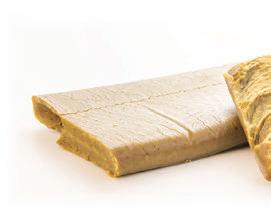
3 minute read
Case Study: Mayorga Organics
Bühler’s recently released PolyCool 1000 cooling die works in combination with an extruder to produce wet-textured proteins.
PHOTO COURTESY OF BÜHLER
engineer for Zeppelin. We try to look at that and provide them that type of plan for the future.”
Plant-based needs
Though they share a lot of the same manufacturing concerns as traditional food producers, manufacturers of plant-based foods that are meant to mimic animal meat add a few other challenges to the mix: overall product appearance, texture, mouthfeel, fl avor, and color all must be perfected to fi nd success with consumers, Barber notes.
Having worked in fruits and vegetables for over 20 years, Dave Reynolds, sales and business development manager for Bühler’s protein solutions and ingredients group, has watched the transition as some of those produce items have become ingredients for plant-based alternative meats, cheeses, etc. “It’s been a pretty good swing of integrating a lot of the traditional ingredients into some of these mainstream burger patties and chicken, and getting their ingredients into some of the soy- and peabased products,” he says.
It’s not just about soy and pea proteins these days. At this year’s IFT First—an exhibit focused on innovation—plant-based stole the show, with companies showing o proteins from chickpeas, mung beans, fava beans, algae, and more. There are a lot of decisions to be made when choosing ingredients designed for a plant-based product to replicate a meat product. What has the right taste might not have the right texture. Or what worked in a lab might not work as well when scaled up.
“The choice of the ingredients in the formulation is crucial for the success of plant-based foods. The functionalities provided by the protein are directly related to their source, their internal composition content, and the process that has been used to concentrate or isolate the protein,” Barber says. “After choosing those ingredients, the best way is to test them through an extruder to see their ability to create the expected fi bration, expansion, texture, aspect, and more.”
A lot of researchers and start-up companies start with a good base, certain ingredients that they want to use, Reynolds comments. “Then we work with them to try to fi gure out—OK, going from making a couple of patties into making 6,000 patties or scaling them up from kitchen to commercial,” he says. “Do they want a product that is shelf stable? Or do they want to go straight to the frozen food or the meat section? Or is there a combination of both? A lot of where we fall in is trying to adapt and combine that capacity and the texture and the taste at those high rates so that they can sell it.”
The protein ingredients themselves have become a big business, with several startups realizing how expensive a full fi nished product line can be to develop. Instead, they focus on providing ingredients with good functionality to the larger fi nished goods companies.
Beyond the burger
It’s not just the ingredients that are evolving. The plant-based products that were entering the market three or four years ago were largely burger formats like the Impossible and Beyond burgers. To make those, food producers would use the texturized vegetable protein (TVP) created with dry extrusion processes, rewet them, and add other ingredients to then form into burgers. These days, though, the Holy Grail of plant-based meat alternatives is to come up with analogues to whole cuts of meat. “The biggest thing is who’s going to come up with the best whole muscle—a steak, breast, chop, what have you,” comments John Sheehy, global key account manager for plant-based foods at Coperion K-Tron.
That’s a whole di erent beast than ground beef analogues. It requires a shift from dry extrusion to high-moisture extrusion. Instead of a typical shelf life of years for the TVP, the product that comes from wet extrusion has to be treated more like real meat, with refrigeration, freezing, and post-processing that goes along with it, Reynolds notes.
But high-moisture extrusion also has throughput and size limitations that dry extrusion doesn’t face. “The high-moisture product, when it leaves the extruder, it’s only about 4.5 in. wide and maybe 0.6 in. thick,” Sheehy says. “The big push in the industry is to increase the capacity of the cooling die. Right now, it’s the bottleneck.”
It’s no trivial matter what type of protein formulation you ultimately decide on. Most systems will be modifi ed to accommodate that specifi c recipe. Sheehy comments on just a few of the considerations for extruders: “The biggest thing you’re going to have to change is the inside of the barrel







